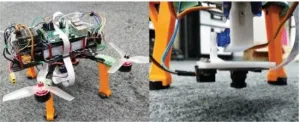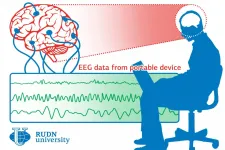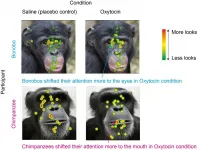(Press-News.org) Initially earmarked for covert military operations, unmanned aerial vehicles (UAVs) or drones have since gained tremendous popularity, which has broadened the scope of their use. In fact, "remote pilot" drones have been largely replaced by "autonomous" drones for applications in various fields. One such application is their usage in rescue missions following a natural or man-made disaster. However, this often requires the drones to be able to land safely on uneven terrain--which can be very difficult to execute.
"While it is desirable to automate the landing using a depth camera that can gauge terrain unevenness and find suitable landing spots, a framework serving as a useful base needs to be developed first," observes Dr. Chinthaka Premachandra from Shibaura Institute of Technology (SIT), Japan, whose research group studies potential applications of camera-based quadrocopter drones.
Accordingly, Dr. Premachandra and his team set out to design an automatic landing system; they have detailed their approach in their latest study published in IEEE Access. To keep things simple, they upgraded a standard radio control (RC)-based drone with necessary hardware and software and equipped it with a simple 2D camera for the detection of a symbolized landing pad.
"The challenges in our project were two-fold. On the one hand, we needed a robust and cost-effective image-processing algorithm to provide position feedback to the controller. On the other, we required a fail-safe switch logic that would allow the pilot to abort the autonomous mode whenever required, preventing accidents during tests," explains Dr. Premachandra.
Eventually, the team came up with a design that comprised the following components: a commercial flight controller (for attitude control), a Raspberry Pi 3B+ (for autonomous position control), a wide-angle modified Raspberry Pi v1.3 camera (for horizontal feedback), a servo gimbal (for camera usage control), a Time-of-Flight (ToF) module (as feedback sensor for the drone height), a multiplexer (for switching between manual and auto modes), an "anti-windup" PID controller (for height control), and two PD controllers (for horizontal movement control).
In addition, they implemented an image-processing algorithm that detected a distinctive landing symbol (in the shape of "H") in real time and converted the image pixels into physical coordinates, which generated a horizontal feedback. Interestingly, they found that introducing an adaptive "region of interest" helped speed up the computation of the camera's vertical distance to the landing symbol, greatly reducing the computing time--from 12-14 milliseconds to a meagre 3 milliseconds!
Following detection, the system accomplished the landing process in two steps: flying towards the landing spot and hovering over it while maintaining the height, and then actually landing vertically. Both these steps were automated and therefore controlled by the Raspberry Pi module.
While examining the landing, the research team noticed a disturbance in landing behavior, which they attributed to an aerodynamic lift acting on the quadrocopter. However, this problem could be overcome by boosting the gain of the PID controller. In general, performance during the landing process indicated a properly functioning autonomous system.
With these results, Dr. Premachandra and his team look forward to upgrading their system with a depth camera and thus enabling drones to find even more applications pertaining to daily life. "Our study was primarily motivated by the application of drones in rescue missions--But it shows that drones can, in future, find use in indoor operations such as indoor transportation and inspection, which can reduce a lot of manual labor," concludes Prof. Premachandra.
INFORMATION:
Reference
Title of original paper: Development of an Automated Camera-Based Drone Landing System
Journal: IEEE Access
DOI: 10.1109/ACCESS.2020.3034948
About Shibaura Institute of Technology (SIT), Japan
Shibaura Institute of Technology (SIT) is a private university with campuses in Tokyo and Saitama. Since the establishment of its predecessor, Tokyo Higher School of Industry and Commerce, in 1927, it has maintained "learning through practice" as its philosophy in the education of engineers. SIT was the only private science and engineering university selected for the Top Global University Project sponsored by the Ministry of Education, Culture, Sports, Science and Technology and will receive support from the ministry for 10 years starting from the 2014 academic year. Its motto, "Nurturing engineers who learn from society and contribute to society," reflects its mission of fostering scientists and engineers who can contribute to the sustainable growth of the world by exposing their over 8,000 students to culturally diverse environments, where they learn to cope, collaborate, and relate with fellow students from around the world.
Website: https://www.shibaura-it.ac.jp/en/
About Professor Chinthaka Premachandra from SIT, Japan
Chinthaka Premachandra is a manager of the Image Processing and Robotics Laboratory at SIT where he became an Associate Professor at the Department of Electronic Engineering, Graduate School of Engineering and Science in 2018. His laboratory conducts research in image processing and robotics. His research interests include AI, computer vision, pattern recognition, speed up image processing, camera-based intelligent transport systems, terrestrial robotic systems, flying robotic systems, and integration of terrestrial robot and flying robot. He received the FIT Best Paper Award from IEICE in 2009 and the FIT Young Researchers Award from IPSJ in 2010.
Funding Information
This study was funded by the Branding Research Fund of SIT, Japan.
A neurosurgeon from RUDN University studied the mental activity of developers at work. In his novel method, he combined mobile EEG devices and software that analyzes neurophysiological data. The results of the study were published in the materials of the 23rd Euromicro Conference on Digital System Design (DSD).
To collect data about the activity of specific areas of the brain, one can use functional magnetic resonance imaging (fMRI). However, this method involves massive equipment and is only available at clinics or laboratories. Therefore, it is quite difficult to register human mental activity in a natural environment. Even if usual conditions are reproduced in a lab, the very fact that it is an experiment would still affect the behavior of the participants. ...
Peer-reviewed / Modelling / People
UK modelling study estimates 59% of SARS-CoV-2 transmission may be prevented by completing the WHO recommended 14-day quarantine period after exposure to a confirmed COVID-19 case
Model assumes that quarantine adherence levels are moderate, with 67% of people completing the recommended 14-day isolation period after testing positive for COVID-19 and 50% of contacts of confirmed cases completing 14 days of quarantine.
A similar proportion of transmission could be prevented with only 7 days of quarantine (assuming the same level of adherence) if a COVID-19 ...
In normal times, end-of-life care discussions are most commonly led by senior doctors. However, new research from a busy London hospital shows that the high numbers of deaths taking place in hospitals during the COVID-19 pandemic, frequently out-of-hours, is leading to junior (foundation level) doctors having to lead on these difficult discussions with families, often with no formal experience or training.
The study is by Dr Edmund Lodwick, King's College Hospital NHS Trust, London, UK, and presented at this month's Winter Scientific Meeting of the Association of Anaesthetists, held online. He analysed the situation at Croydon University Hospital, London, where he spent his own foundation level training. This is a typically busy London hospital ...
Researchers say they have been able to greatly improve the readout of data from digital memories - thanks to a phenomenon known as 'quantum entanglement'.
The research team, which included researchers from the Italian Institute of Metrological Research (INRIM) and the University of York, say the findings could have major applications for digital storage devices, including optical memories such as CD or BluRay disks.
This is the first experimental demonstration that quantum sources of light can enhance the readout of information from digital memories, an advance that could potentially lead to faster access of data in large databases and to construct memories with higher capacities in our next-generation computers.
In an ...
TAMPA, Fla. -- Evolution within groups of tumor cells follows the principles of natural selection, as evolution in pathogenic microbes. That is, the diversity of cellular characteristics within a group leads to differences in the ability of cells to survive and divide, which leads to selection for cells that bear characteristics that are most fit to the malignant environment. The ability to continuously create a diverse set of new cellular features enables cancers to develop the ability to grow in new tissue environments and to acquire resistance to anti-cancer drugs. The diversity of cell characteristics within ...
European eels spawn in the subtropical Sargasso Sea but spend most of their adult life in a range of fresh- and brackish waters, across Europe and Northern Africa. How eels adapt to such diverse environments has long puzzled biologists. Using whole-genome analysis, a team of scientists led from Uppsala University provides conclusive evidence that all European eels belong to a single panmictic population irrespective of where they spend their adult life, an extraordinary finding for a species living under such variable environmental conditions. The study is published in PNAS, the Proceedings of the National Academy of Sciences.
How species adapt to the environment is of fundamental importance in biology. Genetic changes that facilitate survival in individuals occupying new or variable environments ...
Japan -- Despite being our two closest relatives -- separated by just two million years of evolution from one another and six million from us -- chimpanzees, bonobos, and humans have numerous important differences, such as in lethal aggression demonstrated by chimpanzee males and the high social status of bonobo females.
Now a research study suggests that the hormone oxytocin may have played a central role in this evolutionary divergence.
"Oxytocin is a hormone neuropeptide found in mammals," explains author James Brooks, "but despite its ancient origins, its role can vary even among closely-related species." Among these roles are a wide array of social behaviors, some of which have recently been associated with certain species-typical behaviors in great apes.
Based on these behavioral ...
Staphylococcus aureus (S. aureus) ranks among the globally most important causes of infections in humans and is considered a dreaded hospital pathogen. Active and passive immunisation against multi-resistant strains is seen as a potentially valuable alternative to antibiotic therapy. However, all vaccine candidates so far have been clinically unsuccessful. With an epitope-based immunisation, scientists at Cologne University Hospital and the German Center for Infection Research (DZIF) have now described a new vaccination strategy against S. aureus in the Nature Partner Journal NPJ VACCINES.
S. aureus causes life-threatening conditions such as deep wound infections, sepsis, endocarditis, ...
PITTSBURGH--A smile that lifts the cheeks and crinkles the eyes is thought by many to be truly genuine. But new research at Carnegie Mellon University casts doubt on whether this joyful facial expression necessarily tells others how a person really feels inside.
In fact, these "smiling eye" smiles, called Duchenne smiles, seem to be related to smile intensity, rather than acting as an indicator of whether a person is happy or not, said Jeffrey Girard, a former post-doctoral researcher at CMU's Language Technologies Institute.
"I do think it's possible that we might ...
An international research team has developed a fast and affordable quantum random number generator. The device created by scientists from NUST MISIS, Russian Quantum Center, University of Oxford, Goldsmiths, University of London and Freie Universität Berlin produces randomness at a rate of 8.05 gigabits per second, which makes it the fastest random number generator of its kind. The study published in Physical Review X is a promising starting point for the development of commercial random number generators for cryptography and complex systems modeling.
INFORMATION: ...





